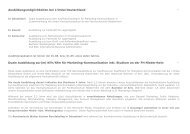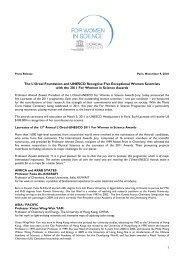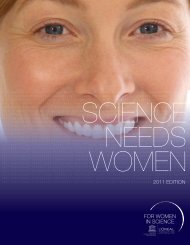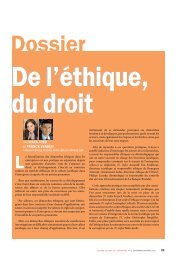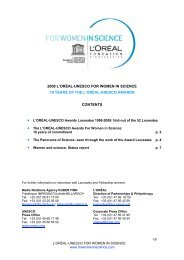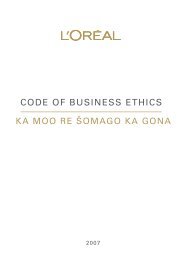CONTENTS - L'Oréal
CONTENTS - L'Oréal
CONTENTS - L'Oréal
You also want an ePaper? Increase the reach of your titles
YUMPU automatically turns print PDFs into web optimized ePapers that Google loves.
L’ORÉAL-UNESCO FOR WOMEN IN SCIENCE 2005<br />
L’ORÉAL-UNESCO AWARDS 2005: The Laureates<br />
interfaces, she has obtained novel experimental<br />
observations and developed theories to interpret them.<br />
Since the 1990s she has made many key contributions to<br />
the understanding of foams, with numerous applications<br />
for industry.<br />
Dominique Langevin is the author of some 150 scientific<br />
publications and has received a number of prizes and<br />
awards. She has played an instrumental role in<br />
developing European level networks and consortia, and<br />
continues to be a scientific leader as well as a scientist.<br />
Context of the Laureate’s research<br />
Dominique Langevin or the fascinating<br />
universe of liquids<br />
By developing several original experimental methods for<br />
the study of physical phenomena occurring at the surface<br />
of liquids, by measuring with great precision their<br />
superficial tension, and by better understanding the role<br />
of surfactants - those substances that give liquids useful<br />
properties for future applications - Dominique Langevin<br />
has greatly contributed to advancing the physics of<br />
liquids. For this substance between oil and water, she<br />
has developed techniques and analytical approaches that<br />
are envied (and at times copied) by other scientific teams<br />
around the world. A small weight for a large volume is<br />
one (too) brief way one might define the foams and<br />
emulsions that Dominique Langevin has studied at the<br />
CNRS; these products that flow too easily through your<br />
fingers are a real challenge for experimental scientists!<br />
And a paradox. What could be more ordinary than bath<br />
bubbles, a draft beer, a tube of makeup, an emulsifier,<br />
decorative and colored foams and liquids?<br />
We use these products every day; at times we eat and<br />
drink them. We do not necessarily ask ourselves how<br />
they become a little more sophisticated each day in their<br />
applications (i.e., putting out fires, preparing food<br />
products and cosmetics, soil decontamination, and so<br />
on). And what about tomorrow? By digging deeper into<br />
the secrets of soft matter, new and more surprising<br />
developments will become possible: imagine being able<br />
to extract heavy petroleum trapped in underground rocks<br />
(an estimated 50% of global reserves) or using solid<br />
foams to build structures on planets that do not have the<br />
Earth’s gravity, or inventing "smart" vectors for gene<br />
therapy. Dominique Langevin has published some 150<br />
articles in leading international scientific journals and is<br />
one of the 4,000 chemists most often cited for the period<br />
from 1981 to 1997. Despite her accomplishments in this<br />
field, she wishes wholeheartedly for an improved<br />
understanding of the stability of foams (why does a<br />
bubble burst?) and emulsions, which illustrates the<br />
difficulty and future dynamics of this discipline.<br />
Scientific context<br />
In the mid-60s, Pierre-Gilles de Gennes introduced<br />
so-called "soft-matter physics" in France (a field that is<br />
better known today thanks to the media attention for his<br />
work on glues). New areas of research then opened in<br />
order to better understand the universe of these curious<br />
fluids (such as liquid crystals, produced industrially at<br />
the end of the 1960s). Was it fate or a stroke of luck when<br />
Dominique Langevin enrolled at the Ecole Normale de<br />
Paris as an 18-year old student? Her desire to compare<br />
mathematical science (her first love) with harsh reality<br />
(experimental physics) quickly led her to work with<br />
high-caliber scientists. This opportunity was decisive for<br />
her as a woman scientist.<br />
At the Hertzian Spectroscopy Laboratory that is part of<br />
this prestigious research center, her colleagues, all



